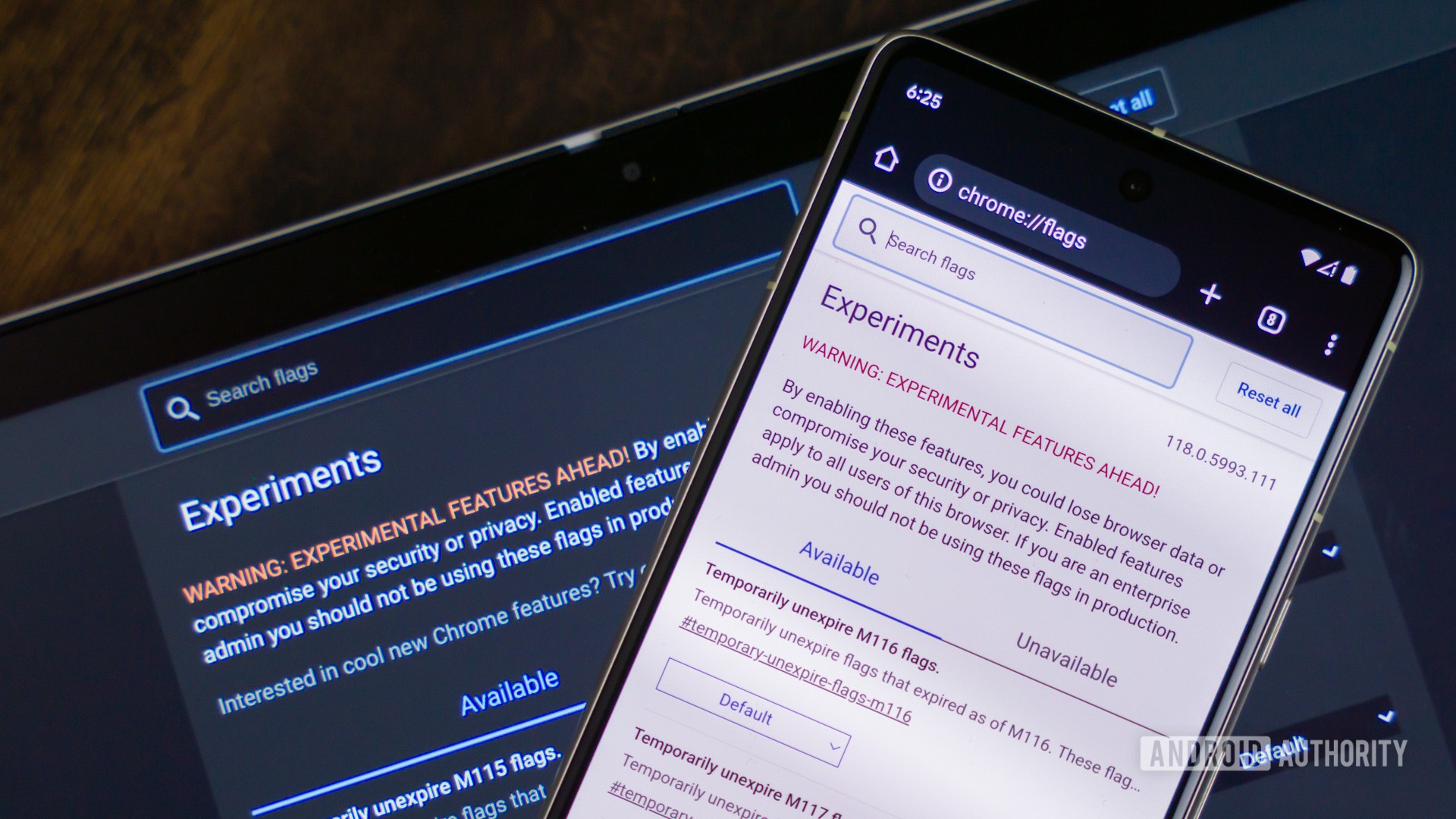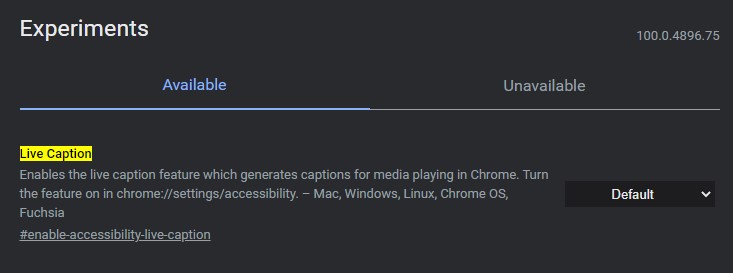Affiliate links on Android Authority may earn us a commission. Learn more.
Here are 12 Chrome Flags that will improve your web-browsing experience

Chrome is known for its simplicity and speed. Despite this, there are a lot of extra tools under the hood. This includes several experimental features that can be accessed through special Chrome Flags.
Considering these are all test features that might not even make it to the stable version of Chrome, bugs are expected. Nonetheless, if you are willing to go through the occasional hiccup, some enable an improved browsing experience. Let’s take a look at some of our favorites.
What is a Chrome Flag?
Chrome Flags are experimental features Google hasn’t released yet, but you can access and try. Just remember these aren’t ready for an official release just yet. This means they may not work very well all of the time. You may encounter the occasional hiccup, bug, or crash.
How do you access Chrome Flags settings?
No matter how much you dig into menus and options, you won’t find them in the settings unless you know how to access this section. You need to know your way in!
How to access the Chrome Flags page:
- Open Chrome.
- Click on the address and delete any URL that might be in it.
- Type the following in the address bar: “chrome://flags/” (without quotation marks).
- Press Enter.
- You are in!
By the way, these steps work both on mobile and desktop. That said, not all Chrome Flags are available for all platforms. There are two primary tabs on the page: Available and Unavailable. Some of these experimental features are only available on specific devices. You can’t use features made for Android on devices like a laptop, for example.
How to enable a Chrome Flag:
- Once you find yourself within the page, go ahead and search for the Chrome Flag you want to try out.
- Select the drop-down menu under the Flag you want to use. It usually reads either Default or Disabled.
- Select Enabled.
- You’ll need to relaunch Chrome most of the time. Hit Relaunch if the option shows up.
Note: These instructions were assembled using a Google Pixel 7 running Android 14. These steps are identical across all Chrome browsers, though. The same steps will work on desktop and iOS.
Are Chrome Flags safe?
Once in the Chrome Flags settings, you will see a warning message telling you about the dangers of using them. This is because experimental features can cause issues and hiccups in the browser. They are usually not too unstable, but some can be. Regardless, you can easily disable them.
How to disable Chrome Flags:
- Access the Chrome Flags settings as directed in the previous section.
- Find the experimental Chrome Flag you want to disable.
- Select the drop-down menu and select Disabled.
- Alternatively, you can press the button in the top-right corner that says Reset all to deactivate all of them.
- You’ll need to relaunch Chrome most of the time. Hit Relaunch if the option shows up.
The best Chrome Flags
Editor’s note: We’ll regularly update this list with new Chrome Flags. All instructions moving forward were put together using a custom PC running Windows 11 and Chrome version 122.0.6261.129, unless otherwise specified.
Smooth Scrolling

Ever notice your scrolling stutter or that it can get a bit sluggish? There could be many reasons it’s happening, but this Chrome Flag will likely improve the situation. Search for “Smooth Scrolling” in the search bar and enable the feature. It’s a great feature Android users should enable, but you can also use it on Windows, Linux, and Chrome OS.
Touch UI Layout

Many convertible laptops, Windows tablets, and other devices now come with capable touch screens. This makes it possible to interact with content more naturally. Sometimes, the desktop interface doesn’t work well with touch commands, though. The browser has a touch-optimized UI hidden in the Chrome Flags.
In the search bar, search for “Touch UI Layout.” Click on the drop-down menu next to it and select Enabled.
Experimental QUIC Protocol

Certain Chrome Flags speed up your browsing experience. QUIC is Google’s protocol, and it’s designed to make the web faster. Enabling this one will speed things up, but only when websites have been optimized for it. Something is better than nothing, though!
On the main page, search for “Experimental QUIC Protocol.” Click on the drop-down menu next to it and select Enabled.
Enable Zero-copy rasterizer

If you want Chrome’s general performance to be faster, one neat trick is to enable Zero-copy rasterizer. This will allow Chrome threads to write directly to the GPU for tile management. In turn, Chrome should operate faster, at least theoretically. Whether you’ll actually notice a difference is another story. Also, it makes Chrome more prone to crashes. You can definitely give it a try, though.
Search for “Zero-copy rasterizer” and enable it in the drop-down Chrome Flags menu.
Auto Dark Mode for Web Contents

Dark Mode is pretty cool, both aesthetically and for eye comfort reasons. If you are also a fan of it, you want all website content to support it. Sadly, not all websites cooperate, but a secondary option forces the option on all websites.
Open the Chrome Flags page and search for “Auto Dark Mode for Web Contents.” Enable the feature through the drop-down menu next to it.
Parallel Downloading Chrome Flag

Waiting for large files to download can be a hassle. Let’s cut delays by dividing downloads into multiple files to be downloaded simultaneously.
Search for “Parallel Downloading” and enable the feature using the drop-down menu to the right.
Show autofill predictions

Nobody likes filling out forms, so Google simplifies this process using autofill. Still annoying? You can automatically have Chrome autofill form information by enabling the “Show autofill predictions” feature.
Search for “Show Autofill Predictions” and enable the feature using the drop-down menu to the right.
Live Caption

Some video players and websites offer captions, but this isn’t a universal feature. Those who want transcripts for all recognized words in media can use the Live Caption Chrome Flag.
Search for “Live Caption” and enable it.
GPU Rasterization

Is Chrome simply not fast enough for you? We know how you can harness the full power of your computer to speed things up. There’s a trick, though; you need to have a dedicated GPU for this one to make any improvements to Chrome’s performance. GPU Rasterization allows Chrome to take some of the workload off the CPU and have your GPU take care of it.
Here’s how to do it. Search for “GPU rasterization” and enable the feature using the drop-down menu.
Chrome Refresh 2023

Chrome is starting to look a bit outdated, right? Everything is kind of square and dull. If you want a more modern design, go into the Chrome Flags and enable “Chrome Refresh 2023.” The new design hasn’t been pushed out to all users, but Google has been working on it. It resembles Material You, with more colorful and playful hues and rounded corners. Additionally, it will feel better on touchscreen devices, as Material You is a mobile-focused design language.
Override software rendering list

GPU acceleration on Chrome is usually only available for supported devices. But, of course, there is a Chrome Flag for nearly everything. You can force Chrome to use GPU acceleration, even on unsupported devices. Just be warned that this may cause compatibility issues, as systems are often not supported for a reason.
Just look for “Override software rendering list” and enable the Chrome Flag.
Partial swap

Partial Swap improves memory management, and can supercharge your browser’s performance. It basically swaps memory usage, prioritizing tabs and tasks you are using at the moment. The thing is, this can also cause issues from time to time.
Partial swap comes enabled by default, so search for “Partial swap” to disable it. Or, if it’s disabled, you can try to enable it and see if it helps.
FAQs
Using Chrome Flags is safe, but it can make your experience a bit buggy. The team also warns you could lose data and compromise privacy. This is just Google being careful, though. The worst that can usually happen is that you’ll need to relaunch Chrome and turn off the Chrome Flags, if anything goes wrong.
Chrome Flags are experimental features the Google team is testing. The team will make these official Chrome features once they are in good working order, if they are deemed worthy. This isn’t always the case, though. Additionally, Chrome Flags are often killed.
You can use Chrome Flags on both mobile and desktop browsers, but not all Chrome lags are available on every device. Some are desktop or mobile-specific. However, Chrome will separate unavailable Flags and put them into the Unavailable tab.